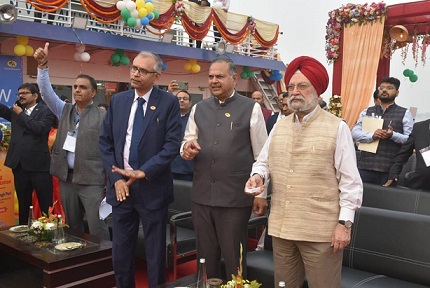India’s natural gas sector is on the threshold of rapid growth backed by increasing demand, greater exploration efforts under the New Exploration Licensing Policy, the commissioning of liquefied natural gas (LNG) import terminals on the western coast, upcoming LNG terminals and the government’s initiatives on a nation-wide natural gas pipeline grid.
On the supply side, additional Regasified LNG (RLNG) terminals, a transmission pipeline network and transnational pipelines would help to meet demand and achieve a higher share of natural gas in the overall installed capacity of energy – from 9% in 2014 to 20% by 2030.
Yet, greater supply will not be able to catch up with the incremental demand, resulting in a shortfall. This shortfall will reduce by 2017-18 due to more LNG imports. However, this deficit is projected to steadily increase again till 2030.

Figures in million metric standard cubic meter per day (MMSCMD). Source: Petroleum and Natural Gas Regulatory Board
Energy availability is the key to economic growth and India is on the cusp of an energy crisis fuelled by the poor availability of coal to fire thermal plants. At present, a little over half of India’s energy needs are met by coal-fired plants. India has lost more than 15 billion units of electricity due to non-availability of coal in the past two fiscal years.
In such a scenario, switching to natural gas to generate power is a prudent choice. Factors such as higher availability, development of transmission and distribution infrastructure, cost savings and its eco-friendly characteristics are propelling its use.
By volume, the power sector accounts for 28% of natural gas consumption in India. In the future, the increased substitution of oil by natural gas is set to alter the primary energy mix; the share of natural gas in the mix is expected to increase to 20% by 2030. A study by the Petroleum and Natural Gas Regulatory Board projected that gas-based power generation would contribute 36% to 47% of the increased demand for natural gas till 2029-2030.
The demand for natural gas persists as it has become easier for users in the power, fertiliser and city gas distribution to switch to gas. Collectively, they accounted for 70% of the natural gas consumption in 2013. A higher emphasis on food security coupled with the increasing price of urea is likely to increase the fertiliser sectors’ dependency on natural gas.
| Power sector gas demand | |
| Year | Demand (in MMSCMD) |
| 2016-17 | 158.88 |
| 2020-21 | 218.88 |
| 2025-26 | 293.88 |
| 2029-30 | 353.88 |
| Source: Petroleum and Natural Gas Regulatory Board | |
In the absence of any major domestic discovery, additional capacity is likely to be filled through RLNG or transitional pipelines. The government should promote environmental conservation through policy support and favourable pricing. At the launch of McKinsey & Company’s report ‘India: Towards Energy Independence 2030’ in early 2014, Paul Sheng, the consultancy’s Hong Kong director, was quoted in Economic Times as saying: “India can reduce its import dependence by 15%-20% by 2030. It will have to introduce appropriate policies to explore domestic resources and offer a viable market to investors.”
Sources:
https://cea.nic.in/reports/monthly/inst_capacity/jun14.pdf
https://articles.economictimes.indiatimes.com/2014-01-15/news/46225656_1_oil-and-natural-gas-imports-india-dependence
‘Vision 2030 – Natural Gas Infrastructure in India’ by the Petroleum and Natural Gas Regulatory Board, https://businesstoday.intoday.in/story/coal-shortage-narendra-modi-coal-india-jsw-steel/1/210634.html




